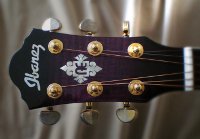Knowing the parts of the guitar will allow the student a better appreciation for it. This lesson will help you become familiar with the guitar. At the conclusion of the lesson, you will no longer need to use the words: “Thing-a-ma-giga” to refer to a guitar part. 😉
Parts of the Guitar Number 1: The Headstock
 An interesting fact about the headstock is the variation in style that you will find from brand to brand. Many guitar makers use the headstock to mark their instruments. For example, a Cordoba classical guitar has a much different headstock than a Vicente Tatay. A Gibson has a much different headstock design than a Fender guitar. The headstock is the part that joins the strings to the guitar. Inside the headstock, you will notice at least 6 pegs. These pegs are also called tuners.
An interesting fact about the headstock is the variation in style that you will find from brand to brand. Many guitar makers use the headstock to mark their instruments. For example, a Cordoba classical guitar has a much different headstock than a Vicente Tatay. A Gibson has a much different headstock design than a Fender guitar. The headstock is the part that joins the strings to the guitar. Inside the headstock, you will notice at least 6 pegs. These pegs are also called tuners.Parts of the Guitar Number 2: The Tuners
Tuners also come in different sizes and shapes. Some are from a combination of metal and plastic, while others are metal. Regardless of the material, having good quality tuners are a must to have a tuned guitar. This becomes more important when playing the guitar with other instruments. As the dissonance is more noticeable.
Parts of the Guitar Number 3: The Nut
Considered the number 1 fret, the nut plays an important role in shaping your guitar tone. Along with the bridge, the nut determines the string spacing. Thus, you should pay close attention to how close or far apart the strings of your guitar are. Take note of the spacing If you find it difficult to fit your fingers on certain tight chords.
Some of the materials used to build this part of the guitar are metal, graphite, plastic, and bone, to name a few. Most budget guitars feature a plastic nut. So, one of the first things to upgrade on your budget guitar should be the nut.
Parts of the Guitar Number 4: The Neck
Parts of the Guitar Number 5: The Top
The top of the guitar body. The soundboard and the guitar body serve as a natural amplifier. Together they amplify the vibrations of the strings to produce sound. In the case of classical guitars, the sound is warm and relaxing. Guitar luthiers spend years searching for the best woods to use as soundboards. Soundboards are also known as Resonance tops. Resonance tops are critical to the sound the guitar produce by the strings.
Parts of the Guitar Number 6: The Bridge
The bridge helps tie the strings. The bridge helps send the vibrations of the strings to the body and soundboard of the guitar. The bridge is one of the most diverse parts of the guitar. From solid pieces of wood to floating metal blocks. Each guitar style has a particular bridge characteristic to it. The bridges are from the same material as the nut, including graphite. Bridge styles are even known by their brand names, such as the Bigsby.
